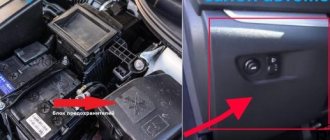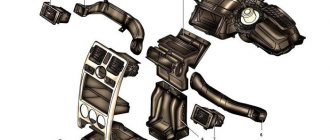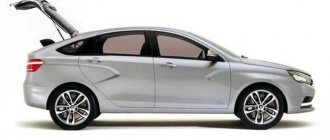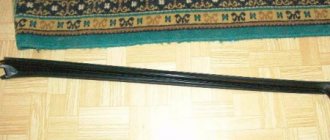Are the technical parameters comparable?
So, our task is to understand what is closer to buyers of the Lada Grant or the Lada Priora? Aspects of this issue lie in many reviews from owners who do not see significant differences between the modifications present here. This is not surprising, since the cars are equipped with identical engines and almost identical transmission units.
In the Priora model range, there are two units: a 98-horsepower version and a 106-horsepower version. Granta already boasts 4 modifications of engines: less forced, 82- and 87-horsepower versions are added to the two mentioned ones.
Much more attention is paid to the “sick” components of the Priora - the struts and the electric power steering. The manufacturer claims that these shortcomings have been eliminated in the updated modification
A significant problem with Priora is the risk of valves bending when the timing belt breaks. In the modified engine “21127” this drawback also could not be eliminated. It seems that it will not be possible to “hide” from this problem in the future, since according to persistent rumors that are gaining momentum, this model has been “standing” on the assembly line for the last year.
During the three-year period of operation of the Grant, no significant deficiencies were identified. As an exception, the generator bearing is presented, which is prone to frequent failure.
When choosing between two competitors LADA Granta or LADA Priora, you should not forget about the aspects we have given. Our sympathies, according to the tradition already formed here, move towards Granta.
Noise insulation
If we compare Lada Vesta and Lada Priora in terms of noise insulation, then the first car will have advantages. The difference is especially noticeable when driving on the highway at high speed.
The noise in the Priora is audible, even if additional sound insulation is installed, the howling of the engine does not disappear. In Vesta, the engine is audible only when operating at high speeds, and with the windows closed, oncoming cars can be heard when they are at a minimum distance from Vesta.
There are practically no extraneous noises, it feels like you are driving a prestigious foreign car. The brakes in Lada Vesta or Lada Priora are the same, both cars brake quite well. What corresponds to this class of car.
Rate the article!
Body and dimensions
When choosing Grant or Priora in this category, you must give the palm to the first car. Two body modifications are available for it: sedan and liftback. Priora buyers can rely exclusively on a five-door sedan.
Lada Priora is slightly longer than its competitor, although the height and width of the Granta are greater. And it has a trunk of as much as 520 liters (the Priora has only 430 liters, but here you can fold the rear seat to increase the volume to 700 liters).
- length – 435 cm;
- height – 142 cm;
- width – 168 cm;
- wheelbase - 249.2 cm.
- length – 426 cm;
- height – 150 cm;
- width – 170 cm;
- wheelbase - 247.6 cm.
If we discuss the ground clearance indicator, then for the Priora it is 16.5 cm, and for the Granta it is 16 cm. In principle, a very insignificant difference. However, if the Lada Granta comes with an automatic gearbox, the ground clearance will decrease to 14.5 cm.
As a result, Priora is distinguished by increased cross-country ability, while for its competitor off-road conditions can become an insurmountable task.
Next is a video about the confrontation between the Lada Granta and the Lada Priora:
Body
In the future, the manufacturer plans to expand the model range of bodies. When developing West, the Priora served as the base car. Despite this, it has little in common with the original; the car acquired a unique design with an increased length and width of the body. If we compare the design of Lada Vesta vs Lada Priora, we can definitely say that the new model is much better than its predecessor.
Comparison of Lada Vesta and Lada Priora Vesta is distinguished by a modern design in a European style. The appearance of the Priora is archaic; it does not have a single element that can compete with its counterpart. The AvtoVAZ developers were faced with the task of creating a design that would be the most elegant and beautiful in our automotive industry. And they succeeded.
LADA Priora
This model is an iconic domestic car. Produced since 2007, and restyled in 2013. However, it could not withstand the competition within the brand. After the release of new models, the demand for LADA Priora decreased.
Then, the car left the assembly line in Togliatti at the end of July 2021, according to the official LADA website. This brand has been undergoing significant changes over the past three years, in the period 2015-2018. A new generation of cars of this brand is being produced.
The average price of a new car Priora (sedan) 1st generation (2013 - 2018), 1.6 liters, front-wheel drive, maximum power available - 106 hp. is about 470,000 rubles if we consider a manual transmission (manual transmission 5) and more than 500,000 rubles - a robot (manual transmission 5). On the secondary market, the price is significantly lower than 320,000 and 380,000 rubles, respectively.
The body has a rather laconic appearance, like an old model, with a wide range of colors. The interior is also distinguished by its simplicity, but at the same time comfort (reviews note that the driver's seat is well padded).
As for technical equipment, the average fuel tank volume is 43 liters for AI-95 gasoline, the engine capacity is slightly higher than 1500 cc.
“Priora”: advantages and disadvantages
But the car's struts are a real minus of the model. Considering how unreliable the roads are in our country, the racks simply fall apart. If we make a verdict based on some general parameters, then it should be noted that in this regard, the Lada Priora is not bad. The model still has many buyers.
“Priora” is supplied to the market in two trim levels. These are “Normal” and “Lux”. The first includes front windows, an on-board computer, an airbag, and headlight range control. The second has the same elements, but adds air conditioning, as well as ABC, EBD. There is a noticeable difference between the trim levels and in the appearance of the cars. The luxury model has fog lights, alloy wheels, and parking sensors.
Chassis design features
In all class B models of cars produced by AvtoVAZ, the same components are present in the chassis design. In this case, only the settings differ, and radically.
Even despite this design similarity, Vesta has more ground clearance than Priora, and it handles better on the road; there is practically no wave swing on uneven roads, and there is no roll when cornering.
Vesta passes minor bumps on the road with ease, and passengers in the cabin almost do not notice it. If the potholes on the roads are more significant, then an incomprehensible knocking sound begins to be heard, and passengers and the driver experience discomfort while driving. As experienced Vesta owners say, this defect can be eliminated; for this purpose, you will have to install special washers under the rear pillars.
Engine
The basic equipment of the produced car is equipped with an eight-valve engine with a power of 87 horsepower, as in the first Priora models. Also available to car enthusiasts is a sixteen-valve engine with a capacity of 106 horsepower, identical to that installed on the second model of its predecessor. However, the advantage of the new model of the Russian automobile industry was the appearance of a new engine from NissanSentra, which has a volume of 1.6 liters. Its power is 114 horsepower. The maximum speed of these cars is approximately the same - 185 km/h. As for acceleration, the winner here is obvious - Lada Vesta. It accelerates to 100 km/h in 10.3 seconds, while the Priora requires about 11 seconds.
It is noteworthy that types of cars may soon appear equipped with a powerful engine, the volume of which will be 1.8 liters. In addition, the new model uses a unique system that allows you to refuel the car not only with gasoline, but also with a mixture of gasoline and gas. This was made possible thanks to the new dual-fuel system.
Sequence of assembly of rear seats on Lada Vesta
After all the repair work is completed, you need to correctly put the rear seats of the car in place. To do this, follow the instructions:
- Install vertical backrests.
- Screw them in with special bolts.
- Fasten the seat belt, which is located in the middle.
- Secure the chair in the brackets.
- Gently press the front edge of the chair, finally installing it.
Caution and a serious approach to business will help you quickly and easily dismantle the seats on the Lada Vesta. The process of putting the seats back is easier than removing them and will not take much time. To do everything right, you can watch a video on dismantling the rear seats on a Lada Vesta car.
“I had a limited budget to buy my first car. Using my own means, I planned to buy a Kia Rio or Vesta. After a test drive of both, I decided on a domestic car. It cost less and was more responsive on the road. I’ve been driving since 2021, servicing and changing everything according to plan. I didn’t find any pitfalls.”
“The difference in the price of cars is not so big that we should look towards the Lada.” The interior looks cheap, creaks and scratches easily. The side windows rattle when driving over uneven surfaces. The gearbox is very stiff, you have to make an effort to shift it. I read on a specialized forum what to choose: “Kia Rio” or “Vesta”. I took the Lada and made a mistake.”
“I’ve been driving a Kia Rio since 2021. I’m happy with the car. Very warm interior, pleasant interior lighting, information panel is easy to read. The headlights illuminate the road well at night; you don’t have to think about xenon. The only downside I would note is poor sound insulation. I advise anyone who can’t decide to watch a video on YouTube – “Vesta” or “Kia Rio”.
"Lada Vesta" is suitable for those who want to buy a decent modern car for little money. It performs well on domestic roads and is not expensive to maintain, although it has its technical drawbacks. The Kia Rio has richer equipment and fewer obvious functional problems. But it also costs more.
Both engines are quite demanding on the quality of consumables. The manufacturer recommends using high-quality synthetic or semi-synthetic oils. If we talk about the brand, the best option is to use products from proven brands, for example Liqui Moly, LukOil, Mannol, Mobil and others. The oil volume in the 1.6 engine is 3.5 liters, while in the 1.8 it is 4.4 liters.
Thanks to the modernization, the 21129 unit is endowed with a longer service life - 250 thousand km, compared to 200 thousand declared for the 21127 engine. The 1.8-liter unit has even greater values - 280 thousand km. However, in practice, owners note that with proper maintenance and care of Vesta (timely replacement of engine oil, air filters, checking belt tension, good fuel), the resource of power plants is much longer than stated by the manufacturer.
Comparison of configurations and prices of Grants and Priors
Now about the packages and prices. Lada Priora is the only car in our country that is available in four body styles - sedan, hatchback, station wagon and coupe. If you are a fan of station wagons, then the Priora has no competitors.
Granta is not available in this body style. It is represented on the market as a sedan, a liftback and a sports car. If Priora has two trim levels for all models, Norma and Luxury, then Granta has added a third (the cheapest) Standard.
Interestingly, the inexpensive Priora configurations are much better equipped than similar Grant configurations. But they also cost significantly more. But in the Lux trim levels, the differences between Priora and Grant practically disappear.
The same set of expensive options includes electric power steering, front airbags, heated seats, a modern multimedia system, an on-board computer with many functions, and much more.
And again, the Lada Granta in the most expensive Lux configuration costs 10-15% cheaper than the same Priora. This is achieved due to the fact that the design of the Lada Granta has significantly reduced the number of small parts used in assembling the body.
Hence the reduction in noise levels and the elimination of all sorts of rattles and squeaks that so annoyed previous VAZ owners. The presence of a wide variety of configurations is a huge plus for the Lada Grant, as the car becomes accessible to almost everyone, the main segments of the population.
We deliberately do not provide specific prices for this or that model, but try to show the main trends, because the price gap between different sellers can be very different from each other. Let us conclude that the comparison of Grant and Prior with regard to pricing policy again remains with Grant.
A brief overview of the appearance of Vesta and Priora
Vesta personifies the European modern typical car. The look is quite expensive and prestigious, and the model is in demand on the market. In turn, Priora, although attractive on the outside, is still a rather outdated body type.
Each of the models under consideration is a budget option and is classmates. Many will say without hesitation that Vesta can be placed next to the best foreign cars of the same class. For the automaker AvtoVAZ, this model became a real breakthrough. As for the Priora, it was initially produced in 3 body types: hatchback, station wagon and sedan, at the moment there are only 2 bodies in operation - station wagon and sedan. Vesta is released in exactly these bodies. In terms of exterior, it’s easy to determine which is better when Vesta or Priora is in the balance. Most likely, everyone themselves realized that the fresh solution - Vesta wins this dispute.
Exterior of Priora and Kalina
This is partly a subjective criterion, so each LADA Priora or LADA Kalina model will have its adherents, as well as critics. Although some sensations may be widespread. Kalina evokes associations with a family car, which is better suited to a certain category of buyers, which is facilitated by small wheels and a short hood line.
If the owner is not concerned about demands on the exterior and is not a body esthete, then such a car will not cause rejection.
If you compare the Kalina station wagon or Priora station wagon, then the Priora evokes slightly different feelings in most drivers. There is a certain desire for “respect” here, since the car’s silhouette can resemble a foreign car. This option can be addressed not to practical drivers or women, but to progressive-minded youth who constantly show their business ambitions.
This judgment is partly confirmed by the previously identified technical aspects. Let us remember that Kalina, as befits a family car, is not capable of high speeds or agile dynamics. If we compare, her habitat is urban everyday life.
Priora strives to show its ambitions, which is facilitated by higher dynamic and speed capabilities. Therefore, a considerable proportion of young and energetic subjects are inclined towards chip tuning and other transformations.
The points we have indicated do not allow us to resort to an unambiguous comparison of these models LADA Priora or LADA Kalina. Here, when choosing, the personal preferences of the buyer come to the fore. The functional purpose of the cars is approximately the same, but the features are always different. No one argues that it is possible, through the magic of tuning, to transform Kalina so that she will easily “punish” all the “eggplant sedans” in traffic lights or other races. But this operation will cost the owner more than the modernization of the Priora, since it was this operation that was initially endowed with more significant inclinations in terms of technical aspects. In this regard, it is obvious which is better.
What will “fly” first?
“Most likely, stabilizer bushings,” predicts Evgeniy. — In the first batches, they began to “grunt” already at 3-5 thousand, greatly annoying at every speed bump. Later the problem was solved, but it can still be considered a consumable, just like the racks. By the way, in the Cross version the struts tap slightly when driving slowly over small bumps - a design feature, nothing can be done.
During the same period, you will probably notice annoying twitching of the engine - this is the engine mounts saying hello. They are sinning on the lower one, it is too soft, and because of it, the corrugation of the exhaust system and the other supports of the internal combustion engine wear out more. I recommend proactively replacing all three with tuned ones so that there are fewer problems.
The next consumable is the clutch. The standard Valeo cannot withstand any serious load, I got 30 thousand. A friend on Vesta Sport has about the same picture. And on the “robot”, people started to see the first “bells” even after 8-10 thousand runs. Although there are those who drive even 100 thousand with a manual transmission.
Another candidate for failure are TRW brake pads. The front ones gnaw at the brake disc like a file, and in city mode you may not travel even 30 thousand. The rear ones howl when reversing. By the way, I’m very surprised by the lack of caliper repair kits; just replace them with an original new one for 400-500 rubles. Therefore, if the boot is torn, it is better to immediately go to specialists who repair calipers.
On cross-country modifications, the rear hubs may require replacement at approximately 80,000. This is due to a stiffer chassis, heavier and wider wheels with low-profile tires and offset.
A burst ABS ring on the CV joint can cause trouble. Especially considering that you can’t buy it separately, and the assembled drive costs a fortune. But this problem can be solved, and not everyone has it.”
Comparative test drives
In order to get an accurate answer to the question of what the old Priora can offer, the much more recent and updated Grante, it is necessary to compare cars in each position. The main parameters have always been the length, width and height of the car, as well as the size of the wheelbase. In this case, as expected, Priora comes out ahead, with a body length of 4 meters 35 centimeters and a wheelbase of 2 meters 49.2 centimeters. For Granta these figures are much lower. In this case, the length of the car was 4 meters 26 centimeters, and the wheelbase was 2 meters 47.6 centimeters.
Despite the fact that the Granta has a much shorter car length, it was able to provide exactly the same amount of space for rear passengers as the Priora. Due to the fact that Granta has a much more advanced architectural structure, it can also transport small-sized cargo. Grant's sedan car has a luggage compartment of 480 liters, but the Priora can boast only 430 liters of free space. The situation looks the same with the five-door hatchback, since the wheelbase in this case remains unchanged.
- The length of the Lada Priora is 4 meters 21 centimeters.
- Luggage compartment – 360 liters.
- The length of the Lada Granta is 4 meters 24.6 centimeters.
- Luggage compartment – 440 liters.
Judging solely by the dimensions and spatial features, then in this case, the newer car model looks much more attractive. Father-in-law, Granta outperforms Priora in all respects. Among other things, Granta has a much more unusual and interesting appearance.
Despite all this, Priora is not even going to give up. After all, this car has one hidden ace up its sleeve, in the form of a station wagon, which the Granta simply does not have. The luggage compartment in this case already has an indicator of 444 liters. In addition, it is possible to fold the rear seats and increase this figure to 777 liters of free space. This is simply an ideal option for people who often need to transport small-sized cargo, and who often travel to the countryside or to nature. Unfortunately, it cannot offer such a grant to its buyer.
As for the 3-door coupe car, this option also has its fans and admirers. This is a great option for people who love unusual style in cars.
Salon
In the interior of the Vesta Cross, the ergonomics of the front panel make a pleasant impression. A serious drawback is the inability to display speed information on the on-board computer display, since the analog instrument scales are difficult to read during the day.
But in general, the interior is put together so well that even the plastic trim does not make any squeaks. Noise insulation, as already noted by many reviewers, is better than in the XRay, and is already ahead of that of the concern's previous budget models. Even at a speed of about 130 km/h, you can carry on a conversation (although at such speeds it is better not to be distracted by chatter).
Vesta Cross salon:
Now let's take a look at the ergonomics and equipment of the Lada XRay. Like the exterior, the interior environment doesn't look as great as the 2021 prototype. Compared to Vesta Cross here:
- no central armrest,
- many control buttons are inconvenient (heating, for example) and you still need to reach them,
- the required antifreeze temperature indicator is missing on the dashboard of the XRay hatchback,
- unsatisfactory visibility through the central rearview mirror and generally from behind, since the window behind is too small.
The common problem of both cars is that the multimedia system is not very fast and the navigation is not the most advanced.
Three adult passengers can fit relatively comfortably behind the driver. “Relatively” - because the ergonomics of the rear seats are not conducive to long trips. And even in the maximum configuration, there is no longitudinal adjustment of the sofa and is not expected.
And how did it happen that the trunk of the XRAY is smaller than that of the Vesta?
Overall: alas, Xray loses to Vesta in terms of visibility and interior ergonomics. Although it’s worth mentioning about Vesta’s armrest that it interferes with using the handbrake. It would be better if it were movable.
Let's sum it up
Summing up, it becomes obvious which model is better than Vesta or Priora. AvtoVAZ began to produce excellent cars, and the new Vesta is clear proof of this. Having studied all the parameters of the cars, a potential buyer in the showroom is unlikely to have a question about which model to give his preference to Vesta or Priora.
Modern pipes for water or gas are made of plastic, such pipes are considered more durable than simple metal, you can purchase such pipes in many places, in chain stores, or order a batch via the Internet https://ingplast.ru/polietilenovye-truby/, often when ordering The price online will be lower than in hardware stores.
For Lada Granta liftback:
Length 4246 mm (after restyling - 4250 mm); Width 1700 mm; Height 1500 mm; Wheelbase 2476 mm; Front track width 1430 mm; The rear track width is 1414 mm.
The body dimensions of the two models are approximately the same (except that the Granta is taller), but the Granta looks larger than the Priora due to the raised hood and wider radiator grille. In the liftback body, the trunk lid turns into a mixture of the fifth door of a hatchback and the trunk door of a sedan, due to which it looks a little higher than Grants in other bodies. The Granta's wheelbase is about 1.5 cm longer, which is not so noticeable on the road - the cars are equally good off-road.
What to choose
As a result, choosing a Lada Grant or Priora is not so simple. In principle, more people prefer Grant. There is a larger range of engines with transmissions, and the appearance is somewhat more modern.
True, the starting equipment let us down a little, and the interior looks a little old, but these are minor problems. The Priora is chosen by more respectable middle-aged people who value a quiet ride and the classic appearance of the car.
Next is a video about the choice - Lada Granta or Lada Priora:
The Russian auto industry is always criticized, but VAZ cars are at the top of the sales rankings. For what reasons does the buyer forgive inexpensive finishing materials, errors in assembly and design? This question is easy to answer - price plays an important role. After all, it is absolutely impossible to buy a simple European foreign car for that kind of money.
Which is better - Kalina, Granta or Priora? To find out, you should compare these cars. In 2004, production of the Lada Kalina car began. The first Kalinas were produced in a sedan body, but then they began to be produced in a hatchback body, and then station wagons began to appear.
Rumors about the car began to circulate even before its release. Car enthusiasts were practically not spoiled with information. In this regard, there were a sufficient number of myths. Many car enthusiasts appreciated Kalina's appearance. The streamlined body made it different from other cars. It has a nice dashboard. The center console is designed in a modern style. The noisy operation of the internal combustion engine is a drawback of the model, as is the vibration of the gearshift lever.
In 2007, Priora replaced the “ten”, which underwent a deep restyling, and then a new name was invented. The Priora has a modernized gearbox, new body parts, electric power steering, improved sound insulation, and a new engine. Granta was produced first, like Kalina, as a sedan and then as a hatchback. The car has three trim levels: standard, normal and luxury. These are front-wheel drive cars with a 5-speed manual transmission.
Ride and Handling
The Vesta Cross sedan has the same chassis as the previous SW Cross station wagon and, apart from the body type, there are no significant differences. Their main units are identical, even many body parts are compatible. There is a difference in the suspension design (springs, shock absorbers), and in the bifurcated muffler and plastic body kit, which cannot be installed on a regular Vesta sedan.
The difference in price between just a Lada Vesta and Vesta with the Cross prefix, depending on the version, is 53 – 63 thousand rubles. If you choose between a “cross” sedan and a station wagon, then the cost of the latter will be 32 thousand more expensive - this is a standard surcharge for the two-volume body of the Vesta.
Technical equipment
The 2021 Lada Vesta Cross differs from the previous modification in that the sedan is now equipped with a continuously variable transmission. However, such a gearbox is available only in the maximum configuration. In the initial version, Vesta Cross is produced with a 1.6-liter “aspirated” engine, the maximum output of which is limited to 106 hp, and the torque reaches 148 N*m. This engine is complemented by an electronic control system for direct fuel injection. In combination with a 5-speed manual transmission, the sedan develops the first 100 km/h in 11.9 seconds, while consuming about 7.1 liters of fuel. The maximum speed is 178 km/h.
The next 1.8-liter engine on the list produces 122 hp. useful power, and its thrust reaches 170 N*m. This engine also features electronic fuel injection control. Vesta Cross, in modification with a manual transmission and a top-end unit, accelerates to the first “hundred” in 10.5 seconds and consumes about 7.7 liters. The maximum speed has been increased to 180 km/h. The introduction of a continuously variable variator means that the sedan takes 12.7 seconds to accelerate to “hundreds”, but fuel consumption decreases by 0.2 liters.
Lada Vesta Cross has a standard design for cars of this class. At the front of the car there are MacPherson struts. At the rear, the manufacturer placed a semi-independent suspension. Due to the fact that the cross-sedan's ground clearance has been increased to 203 mm, AvtoVAZ engineers had to replace shock absorbers and springs.
Engine
Working volume, l 1.6 1.8 Working volume, cm3 1596 1774 1800 Cylinder diameter 78 82 0 78 Number of valves 16 Number of cylinders 4 Maximum power, kW 78 90 Maximum power, hp 106 113 122 Rated torque, N•m 148 170 Rpm KW 5800 148 4200 5900 6050 Rpm HP 5800 5900 6050 Rpm NM 4200 3700 3750 Engine arrangement front, transverse Camshaft arrangement DOHC Cylinder arrangement in line in a row Compression ratio 0 11 10.3 0 Fuel type Gasoline Fuel requirements AI-95 AI-92 AI-95 Piston stroke 83.6 75.6 0 83.6 Charge type No Environmental class EURO5
Transmission
Transmission type Mechanical (MT5) Robot (AMT5) CVT (CVT) Mechanical (MT5) Robot (AMT5) Drive type Front Number of gears 5 0 5
Body
Body type Sedan Vehicle type Passenger Body length 4410 Body width 1764 Body height 1497 Wheelbase 2635 Front track 1510 Rear track 1510 Ground clearance 178 All technical. characteristics
The overall dimensions of the car are: Body length 4410
mm Body width
1764
mm Body height
1497
mm Wheelbase
2635
mm Ground clearance
178
mm
Body
Body type Sedan Vehicle type Passenger Body length 4410 Body width 1764 Body height 1497 Wheelbase 2635 Front track 1510 Rear track 1510 Ground clearance 178 All technical. characteristics
Characteristics (summary table)
| Drive unit | Front |
| Body type | Sedan |
| Transmission | Mechanics (5) |
| Engine volume, l | 1.6 |
| Acceleration to 100 km/h, sec | 11.9 |
| Ground clearance, cm | 20.3 |
| Max. speed, km/h | 178 |
| Length, cm | 442.4 |
| Width, cm | 178.5 |
| Height, cm | 152.6 |
| Total seats | 5 |
| Weight, tons | 1.23 |
| Max. power, hp | 106 at 5800 rpm. |
| Max. torque, N*m | 148 at 4200 rpm. |
| Type of power plant (motor) | In-line, 4-cylinder |
| Fuel | AI-92 |
| Supercharger | No |
| Consumption per 100 km in the urban cycle, l. | 9.2 |
| Consumption per 100 km in the extra-urban cycle, l. | 5.8 |
Specifications
Engines
The LADA Vesta engine range is so far even narrower than that of the Priora, as it includes only one engine. The basic version of LADA Priora has an 87-horsepower, 8-valve, injection power unit, the installation of which is planned for Vesta in the future, in order to reduce the price of the latter. In the Priora, this engine produces peak power at 5,100 rpm, and at 3,800 rpm there is all 140 Nm of torque. The car accelerates slowly with it - 12.5 seconds. up to a hundred, and the maximum speed is low and amounts to 176 km/h. But the combined cycle consumption of 7.3 liters, as for a budget engine, is quite acceptable.
8-valve Priora engine. Soon this budget option will appear on Vesta.
The second engine, which is a 106-horsepower 16-valve engine, is available on both models. This is a domestic development of the VAZ-21127 type with an injection power system. Its power is noticeably higher, but it is achieved later - only at 5,800 rpm. But the torque increased slightly - by only 8 Nm (up to 148 Nm), and the speed also increased (up to 4,200 rpm). And it’s worth admitting that with it, LADA Priora turned out to be even more dynamic than its fresh competitor – 11.5 seconds. versus 11.8 sec. when accelerating to hundreds. The same applies to the maximum speed – 183 km/h and 178 km/h. And if we compare it with Vesta, equipped with AMT, the situation turns out to be even more depressing (12.8 seconds and 178 km/h, respectively).
The 106-horsepower AvtoVAZ engine is installed on both models.
This completes the list of available engines. But it is worth noting that AvtoVAZ plans to equip the Lada Vesta with a 1.6-liter Nissan engine of the HR16DE-H4M type, derated to 110 hp. With. In addition, there is also a 1.8-liter unit with a capacity of 122 hp. With. With these engines under the hood, the new product of the Russian concern will not leave a single chance for its rival in terms of dynamics, maximum speed and efficiency. Moreover, equipping Vesta with a 1.8-liter engine should begin in the fall of this year.
Very soon this 1.8-liter power unit will appear under the hood of the Lada Vesta.
As you can see, at the moment the LADA Priora has a slight advantage, which is largely achieved due to its lower weight. But in the near future the situation will change dramatically.
Transmissions
The Priora has only one gearbox - a 5-speed VAZ-2181 type gearbox. Despite the fact that the gear ratios in it are selected quite competently, the unit does not differ in particular driving comfort. The lever is not very conveniently located, and during shifts it often rests against the driver’s seat or leg. In addition, it vibrates when driving, which makes shifting difficult and discourages the desire to touch the lever again.
The “mechanics” on the Priora are no different.
The list of Vesta transmissions is noticeably wider. It has a domestic, 5-speed “mechanics” type VAZ-2180, which was inherited from Priora. However, this gearbox was seriously modified using foreign components. In particular, a gear shift module from Schaeffler (Germany) was used. In addition, the volume of oil used in the gearbox was reduced by 30%, which made shifting more comfortable. Engineers also eliminated vibrations of the lever, and a reinforced secondary shaft and other synchronizers reduced background noise.
But for the new LADA Vesta it was significantly improved, eliminating many of the shortcomings.
The second manual transmission is a French gearbox of the JH3 510 type. It also has 5 gears and in terms of quality of operation it is in no way inferior to the VAZ gearbox - the shifts are clear, the lever is quite short-throw, and there are no cases of gear slippage.
There is no classic automatic transmission in the Lada Vesta. Instead, there is a 5-band robot of the AMT type.
And LADA Vesta also has an AMT-type robotic gearbox in stock. Although this is not a full-fledged “automatic machine,” the “robot” still fully justifies its choice. Shifts are timely and logical, fuel consumption is also quite acceptable. In traffic jams, AMT changes gears more noticeably than automatic transmission, but this is not critical and most of those who decided to buy a Vesta with a “robot” are quite happy with it.
Chassis
From the point of view of design solutions, everything is identical. Both Priora and Vesta have standard MacPherson struts at the front, and a torsion beam is placed at the rear - a common thing for class B. But the chassis settings differ significantly. Despite the fact that the ground clearance of the Lada Vesta is noticeably higher, the handling of the new product is much better. Vesta takes turns more cheerfully, stands more confidently on a straight line, does not go astray while driving on a rough road, etc. In general, it has everything that the Priora lacks.
The chassis of the Lada Priora is not new. The most standard scheme there is.
Of course, we cannot say that the handling of the LADA Priora is terrible. For measured driving around the city and on the highway, it is quite enough. But during sharp turns and at high speeds, there is a lack of precision in reactions, feedback on the steering wheel, etc.
However, the Vesta chassis is structurally similar. But the settings are completely different.
Chassis, ground clearance
The Priora has a ground clearance of 165 mm in the pre-facelift version and 170 mm in the restyled version. The chassis is extremely simple: the front suspension is independent spring, the rear suspension is semi-independent spring. There are ventilated disc brakes at the front and drum brakes at the rear.
For the Granta in the liftback body, the ground clearance in the pre-restyling version was 160 mm, in the restyled version it was 190 mm. The Granta has an independent spring suspension at the front, made by McPherson, and a semi-independent spring at the rear. New front strut supports were installed, the longitudinal angle of the strut was increased and the anti-roll bar was modified. The front brakes are ventilated disc brakes, the rear brakes are drum brakes.
Both front-wheel drive cars are city cars, and in terms of cross-country ability in rural areas, the Lada Priora is still inferior to the restyled Granta liftback. Thanks to the improved suspension and higher ground clearance, the restyled Grant passes through bumps and holes better than the pre-restyling version.
Model design
When choosing between several cars, they often look first at the design and interior - the car should be pleasing to the eye. It’s impossible to say which is better: the Granta liftback or the Priora station wagon – “there’s no match for the taste and color of a friend.” It will be enough to give an objective overview of the design concept of these models.
Serial production of the Lada Priora (VAZ-2170) began in 2007. The car became a continuation of the “ten” family, the body underwent minor changes, but someone still recognized the “ten”. In 2013, it was restyled, DRLs were added to the “droplet headlights”, the rear lights and bumpers were changed, slightly “modernizing” the body. Priora looks rather modest, but is quite consistent with its class of budget cars.
Granta is the first car with smoother design features produced by AvtoVAZ. The model was developed on the basis of the Lada Kalina and received the number VAZ-2190 (sedan body). In 2014, serial production of the Granta liftback began (received the number VAZ-2191). In 2018, there was a global restyling of the entire Grant line and their design underwent significant changes, now the car began to look more aggressive and modern.
First conclusions
So, “Granta” has a more modern, more beautiful design than “Priora”. It is worth noting the fact that both models have a certain basic configuration. And such equipment for the first car costs much less than for the second. Here we can definitely say that in terms of its appearance, the Priora (although it is simply impossible to say that it looks terrible) is still inferior to the Granta. It seems that the scales at this moment should tip in favor of the latest model, but nothing like that happens. The fact is that in terms of seats, the Priora will be much more comfortable. You also need to take into account the quality of the material from which they are made. Thus, “Lada Priora” evens the score. And we will continue to look at the characteristics of these two cars to find out which is better: “Priora” or “Granta Sport”.
Car interior equipment
A comparison of the Lada Vesta and Lada Priora in terms of the internal equipment of the front panel indicates that there are significant differences from the old model. For ease of use of various functions of the on-board computer and radio, a multifunctional steering wheel is installed.
French developers worked on the panel design. As a result, it acquired a modern look, a fairly large color display appeared, and the computer itself, in addition to displaying time, fuel consumption and other minor parameters, now has the ability to use various functions for diagnosing and analyzing the operation of the car.
Below it are mounted control buttons for the air conditioning and radio. There are no difficulties when getting into the driver's seat in Vesta. The Priora is also quite easy to get into, but the Lada has a freer interior, which means more space and makes it easier to get out and into the car.
When the driver sits in the seat for the first time, he has doubts about the visibility of both the windshield and the rear window. But this is a false idea; in fact, the review is good and there are no complaints.
Auto engines











